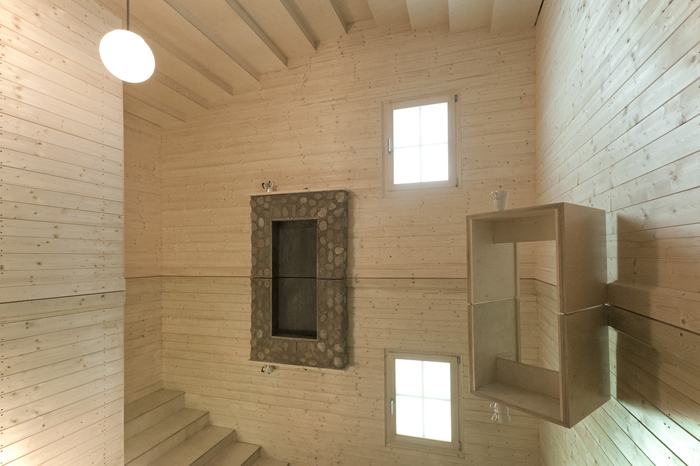
Marcos Lutyens and Raimundas Malašauskas, Hypnotic Show in the Reflection Room, 2012. Performance by appointment through dOCUMENTA (13). Reflection Room designed by Marcos Lutyens; mixed media, 189 ft. 7 in. x 174 ft. 10 in. x 259 ft. 6 in. In collaboration with Sissel Tolaas, commissioned and produced by dOCUMENTA (13). Sissel Tolaas Smell supported by IFF (International Flavor & Fragrances Inc.), New York, and Geza Schoen, Berlin. Courtesy Marcos Lutyens and Raimundas Malašauskas. Photo: Nils Klinger.
Marcos Lutyens rushed out of a small wooden cabin standing among a copse of trees in Kassel’s Karlsaue Park. He was holding a tiny envelope that he presented to my partner and me. The envelope looked empty, but it wasn’t really; it contained a familiar smell that was warm, earthy and deeply calming. Lutyens quickly informed us that the aroma was developed by one of his collaborators, the artist and researcher Sissel Tolaas. It was the smell of fur.
We had just completed a session of Lutyens’ Hypnotic Show (2012) where, by appointment, the artist hypnotized small groups of visitors to dOCUMENTA (13). We sat cross-legged in the interior of his Reflection Room (2012), a specially built cabin inspired by the rooms used at the Fuldatal girls’ home in the former Breitenau Monastery just south of Kassel, where young women were sent to “reflect.” We had not yet learned of the monastery’s complex history, which forms the deep history not only of this piece, but also of much of dOCUMENTA (13). The twelfth-century monastery was used as a concentration camp during the period of National Socialism and as a prison for homeless youth after 1945. A home for troubled girls during the 1960s, Breitenau was closed in 1973, some years after a young leftist journalist, Ulrike Meinhof, exposed the inhumane treatment of its residents to public scrutiny.
At first glance, it looked like Lutyens had covered his cabin floor with mirrors à la Rudolf Stingel, but in fact he constructed an identical, three-dimensional space in reverse, below ground. Normally cordoned off, during the hypnosis sessions visitors were allowed to penetrate this looking glass world, and down there, briefly cut off from the bustle outside, Lutyens guided us through a meditation. In many respects structured much like any hypnotherapy session, this one was built around narrative fragments of Raimundas Malašauskas’s book Paper Exhibition, chosen from a “synesthetic menu” of multi-colored tiles. These narratives, in our case one about a woodland animal and another about contemporary womanhood, were augmented by corresponding scents. Citing his own exhaustion with originality as an art-world value, Lutyens sought with his work the evocation of primary experiences recovered from the unconscious and through the synesthetic. Lutyens commented at the end of our session that he hoped it might help us experience our time at dOCUMENTA (13) more intuitively.
Lutyens’s piece is indicative of what viewers could look forward to in Kassel this summer: an immersive experience that eschews both escapism and spectacle. Hypnotic Show is one example of the new “artistic research,” a contested term used to describe a kind of artistic practice that incorporates modes of inquiry normally confined to the academy. This turn synthesizes two historical instances of art research: surrealism’s “research” into the unconscious and the association of abstraction with perceptual research. The reemergence of both strains is brokered by the interest in relationality and social agency that has dominated the art of the last twenty years. Research has often been posed as an alternative to the literary and historical aspects of artistic tradition. Like many of the new works, Hypnotic Show effectively combines present-tense research with its seeming antitheses—narrative, mediation, and history.
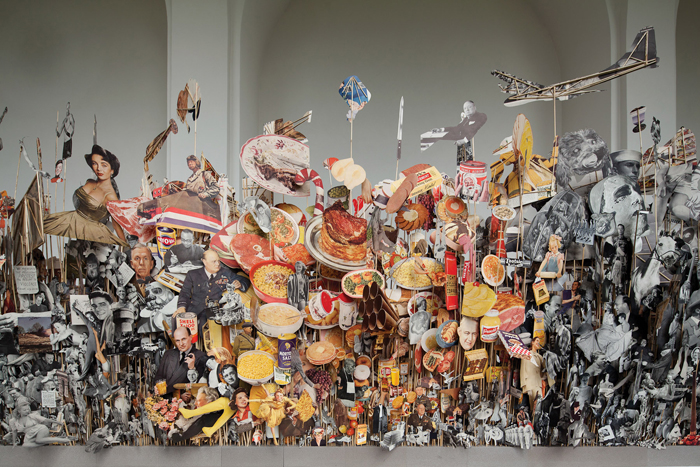
Geoffrey Farmer, Leaves of Grass (detail), 2012. Shadow puppets made from Life magazines (1935 to 1985 displayed in chronological order), tall grass, glue; dimensions vary. Special thanks to the Morris/Trasov Archive. Commissioned and produced by dOCUMENTA (13) with the generous support of the Canada Council for the Arts, British Columbia Arts Council. Photo: Anders Sune Berg.
Hypnotic Show is sensually rich and generous to its participants, but, burdened by its reference to Breitenau, does not entirely forget the coercive history of psychological adjustment. In this respect, it has much in common with Pedro Reyes’s nearby SANATORIUM (2012). A group performance project in the form of a public clinic, the piece provides visitors with a number of treatments for modern psychiatric and spiritual ailments. The treatment cityleaks (2012), wherein the visitor anonymously confesses a secret, is intended to take “confession out of the economy of guilt and into innocuous hearsay.” The vaccination against violence (2012) claims to transform anger management into social catharsis by allowing “patients” to privately beat a disturbing effigy of a person or idea that has hurt them. The young volunteers that run the sanatorium are well-meaning non-experts, and their presence softens the clinical premise into a kind of warm social interaction. A similar conviviality is to be found at the nearby 12 Ballads for the Huguenot House (2012), a collaboration between Theaster Gates and Tino Seghal, where visitors are offered tea in exchange for conversation with the young artists, musicians, and craftspersons living in the temporary collective. These hospitable works, like the deck chairs and cafes parked outside of the major venues, offer welcome recuperation. One of the many threads running through dOCUMENTA (13)—“collapse and recovery”—draws on the historic resurrection of Kassel and other war-torn cities, but also humorously evokes the exhaustion and recovery of the visitors themselves.1 This exhaustion, I would argue, stems not only from the physical demands of viewing a show of this size but also from the particular mode of seeing that this show demands.
I begin with Reyes and Lutyens not only because my own experience of dOCUMENTA (13) began there, but also because their pieces so explicitly fulfill the mandate of this year’s exhibition. The curator, Carolyn Christov-Bakargiev, writes in the exhibition guidebook, “dOCUMENTA (13) is dedicated to artistic research and forms of imagination that explore commitment, matter, things, embodiment and active living in connection with, yet not subordinated to, theory. These are terrains where politics are inseparable from a sensual, energetic, and worldly alliance…”2 As a way of rethinking the connection between the cultural and the political, her definition of “artistic research” seems to me central to understanding dOCUMENTA (13), especially in combination with her use of the “worldly” as both a theoretical and colloquial term. Artistic research as Christov-Bakargiev presents it is inclusive. Even more so than the interdisciplinary research artist of the late 1960s, the contemporary artistic researcher executes open-ended explorations within otherwise defined academic fields, such as psychology in the case of Reyes and Lutyens, but also economics, biology, sociology, and especially history.
Throughout the exhibition, however, artists complicate the analytical character of research by appealing to the irrational. Walid Raad’s Scratching on Things I Could Disavow (2007–ongoing), is a multipart project on the history and role of art in the contemporary Arab world. I was not lucky enough to visit during one of Raad’s scheduled talks, but the multimedia mural that introduces the installation is absorbing on its own. Using a wall covered in cut paper and digital projections that functions like a homemade Prezi, the artist presents his research into the art-world infrastructure emerging in the Middle East.3 The object of Translator’s Introduction: Pension Arts in Dubai (2012) is Artist Pension Trust (APT), an art investment group he claims to have been invited to join. The flowchart tableau, as well as the shrunken gallery that Raad has constructed behind it, speak to his work’s own imbrication in the financial systems of a new Arab art market. But unlike the paper trails offered by someone like Hans Haacke, Raad’s investigations allow for association, fiction, and fantasy to work their way into the data stream. In an accompanying text for the piece Section 139: The Atlas Group (1989–2004) (2012), the artist claims, “In 2005, I was asked to exhibit [The Atlas Group] for the first time at the Sfeir-Semler Gallery, the first of its kind white cube space in Beirut…. When I went to the gallery to inspect my exhibition, I was surprised to find that all my artworks had shrunk to 1/100th of their original size.”4
Scientific methods of ordering and classification were especially apparent in the Ottoneum, Kassel’s natural history museum, which showcased ecological work. The group AND AND AND, dedicated to “critically reexamin[ing] the values, assumptions, and modalities of doing,” organized events that address the commons and alternatives to capitalist life.5 They offered informal meetings daily in the tea garden that they built for the Ottoneum, and a food-and-ecology series that took place at the food kiosk in Karlsaue Park. Inside the museum were low-fi pieces on land use and economic disparity, such as Maria Thereza Alves’s Heroes of the Lake (2012), a study of the flooding around Lake Chaclo in Mexico City, and Claire Pentecost’s Soil-erg (2012), a proposal for a new system of currency based on units of compost. Christian Philipp Müller and Amar Kanwar both investigated the proprietary issues around specific strains of chard and rice respectively. The informative displays downstairs were upstaged by Mark Dion’s beautifully crafted oak display case tucked away on the third floor. The piece houses an unusual eighteenth-century “wood library” and addresses taxonomy through a history of wonder and museological practice.6
The taxonomies continue in the Neue Galerie, where they become even more expressly political by cataloging aspects of unofficial and underground culture. Geoffrey Farmer’s Leaves of Grass (2012)—a fifty-foot long three-dimensional collage of shadow puppets cut from fifty years of LIFE magazines—creates a timeline of American popular culture, while Zanele Muholi’s Faces and Phases (2010–12) uses portrait photography to document a range of lesbian and trans identities in South Africa. Susan Hiller’s installation Die Gedanken sind frei (2011–12) brings together an international history of protest music in a single jukebox as a study in latent or unconscious cultural history. The Croatian artist Sanja Ivekovic´’s The Disobedient (The Revolutionaries) (2012) uses the taxonomic strategy most effectively by borrowing her symbolic imagery from a Nazi-era photograph of a penned donkey labeled as “a concentration camp for stubborn citizens.” Ivekovic´ turns the donkey into an honorific: in a large glass case across from the photograph, an array of stuffed toy donkeys are labeled with the names of individuals who have resisted oppression. Ivekovic´ also contributed a series of brightly colored broadsides displayed throughout Kassel that listed four common reasons that someone could be sentenced to forced labor at the Breitenau Monastery, which became a “work-education” and concentration camp in the 1930s.
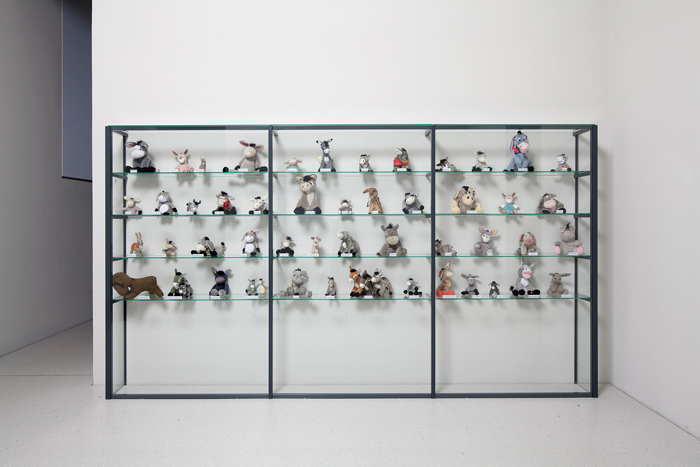
Sanja Ivekovic´, The Disobedient (The Revolutionaries), 2012. Donkey toys, light box, printed text, and mixed media; dimensions variable. Courtesy the artist. Commissioned and produced by dOCUMENTA (13) with the support of the Ministry of Culture of the Republic of Croatia Culturnet Croatia. Photo: Anders Sune Berg.
Lutyens and Ivekovic´ were by no means the only artists with Breitenau on their minds this year. Throughout dOCUMENTA (13), the monastery functioned as a unifying—formerly latent—memory cathartically recovered from the local psyche. Gunnar Richter, the director of the memorial site at Breitenau, contributed an audio slide show on the history of the site that allows the viewer to relive the research process that went into the creation of the Breitenau Memorial, now one of the European Sites of Remembrance. In the Hauptbahnhof train station, Clemens von Wedemeyer installed an impressive 3-channel HD film installation, Muster (Rushes) (2012), which projected a story set at three different moments in the Memorial’s history onto a triangular screen. The film’s three main characters do not remain fixed in their own time period; rather, the actors reappear as multiple characters across the screens and the eras they represent. Like the characters they play, the actors’ mobility mirrors the viewer’s own struggle to square historical memory with personal experience and contemporary values. Many of the media installations in Kassel this year dealt with similar issues of memory but not all as successfully as Wedemeyer. Compared to Javier Téllez’s film Artaud’s Cave (2012), a film about the philosopher’s 1936 trip to Mexico shown nearby in an elaborate cave cinema, Muster addresses historicity and site without resorting to excessive theoretical framing or technical fussiness.
The history of Kassel, where guns and tanks were manufactured for Hitler’s armies in World War II, and the legacy of documenta, which originated as a cultural curative to the Nazi-era ban on Modern or “degenerate” art, were consciously acknowledged in Christov-Bakargiev’s curatorial choices. Sprinkled among the flashy displays by mid-career artists were a number of quieter works by under-acknowledged Moderns, such as the expressionist Charlotte Salomon and the Beat-era abstract painter Etel Adnan. The so-called “brain” of the exhibition, in the rotunda of the Fridericianum, crackles with the associative possibility of a manic archivist—Lee Miller’s photos of World War II are displayed beside objects appearing in the photographs and alongside Man Ray’s metronome of Lee Miller’s eye. Sculptures ranging from 2000 BC to 2012 AD coexist in a space not much bigger than a one-bedroom apartment. The spacious surrounding galleries, on the other hand, are empty but for a gentle breeze produced by the artist Ryan Gander’s I Need Some Meaning I Can Memorise (The Invisible Pull) (2012), and the reinstallation of three small works of modern sculpture by Julio González (1876–1942) originally shown in II. documenta, 1959. Christov-Bakargiev’s vision for contemporary experience, it seems to me, can be found in this interface between the crackle and the breeze.
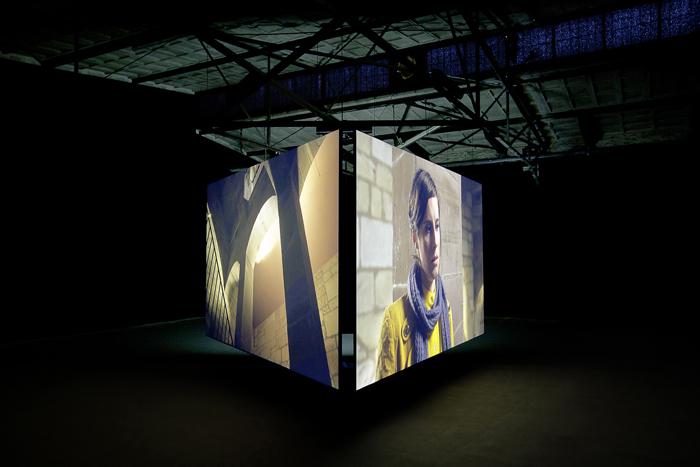
Clemens von Wedemeyer, Muster (Rushes), 2012. Synchronized three-channel HD film installation, color, sound, three screens; 110 Å~ 197 inches; 27 minutes each. Commissioned and produced by dOCUMENTA (13) with support of ZDF 3Sat; Kadist Art Foundation, Paris; Medienboard Berlin Brandenburg; Nordmedia, Hannover; Hessische Filmförderung HR, Frankfurt; Galerie Jocelyn Wolff, Paris. Courtesy of Clemens von Wedemeyer. Photo: Henrik Stromberg.
The research impulse is joined in Christov-Bakargiev’s thinking to another loosely defined concept, the worldly. It appears in the exhibition’s statement of purpose, in the “worldly companions” who lead tours, and most conspicuously in the collaborative piece The Worldly House. An Archive Inspired by Donna Haraway’s Writings on Multi-Species Co-Evolution Compiled and Presented by Tue Greenfort (2012). The house, or shack, a former shelter for the park’s black swan population, sits atop a pond. Inside visitors can read texts by Haraway, and view related films and videos, like Louise Lawler’s Bird Calls (1972), either on a screen or reflected in the fishpond below. Its worldliness is not exactly that of Allan Kaprow’s “Artist as a Man of the World,” though it is surely indebted to Kaprow’s ceremonious liberation of the artist from his garret.7 Rather, Worldly House is both the product of, and a resource for, research. Both Christov-Bakargiev’s concept of research and Haraway’s notion of the worldly emphasize the continual discovery of ever-deeper levels of connectivity, including but not limited to the sociability of other humans.
Connectivity is a twenty-first-century term that suggests an ecology of connectedness among humans, nonhumans, and technology. Dogs, as companion species, are especially visible in works by Pierre Huyghe and Brian Jungen. Greenfort similarly speaks of a “new ethical sensibility” that is not “obscured by the object/subject division.”8 But the concepts of research and worldliness came together, in my experience, as almost absurdly generative; the material generated by Greenfort’s piece alone could occupy a graduate seminar for a couple of years. It is an extreme version of the first-generation conceptualists’ preoccupation with information: “blissful ignorance hasn’t a chance.”9
Christov-Bakargiev quipped during the press preview for dOCUMENTA (13) that, when discussing exhibitions, she likes to tell critics, “There is no concept.” It got a laugh, and with good reason. After a somewhat meandering introduction, her claim that there was no concept seemed to acknowledge the vagueness of contemporary art-speak, and the impossibility of presenting the breadth of today’s art under any unifying banner. Depending on her audience, this position could be taken as bravely destabilizing the confines of academic disciplines and definitions, or, as one of the editors of this essay put it, “closure-phobic.” Imaginative in its selection and layout, the curator and her “agents” have managed to tackle a raft of contemporary issues with a level of humor and eccentricity that is to be commended in a show of this scale.10 Indeed, part of what holds this exhibition together is the force of Christov-Bakargiev’s personal touches, like the Afghan silk scarves worn by the gallery attendants in lieu of badges.
If one is not quite sated by the 193 artists in the show, one need only turn to the 100 pamphlets or “notebooks” that replace the singular, summarizing catalog essay with a multitude of contemporary and historical texts. Some of these also include introductory comments and marginalia from the curator. If that is still not enough, you can turn to the curators’ bookshelf in the dOCUMENTA (13) bookstore, where you can purchase titles from Christov-Bakargiev’s personal library, not to mention the online video glossary where you can watch W. J. T. Mitchell define the word “occupy.” Far from lacking a concept, the show is so rich in concepts as to overload the circuits of anyone with the slightest bit of intellectual curiosity. Nevertheless, the curators balance this (surely self-conscious) overload of information with a valuation of the immediate and the sensual that invokes yet a third facet of the worldly.
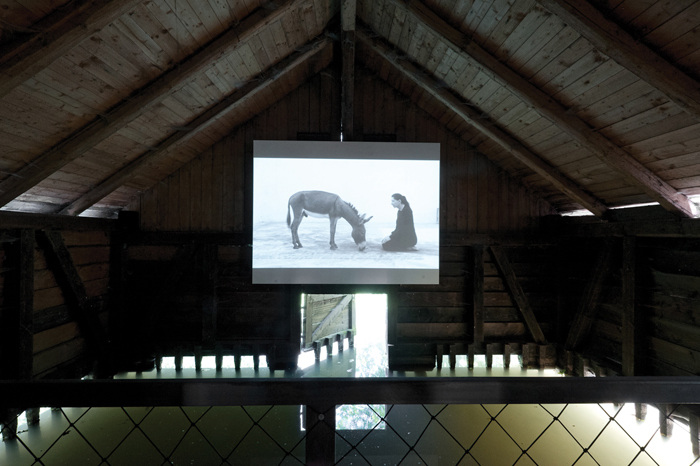
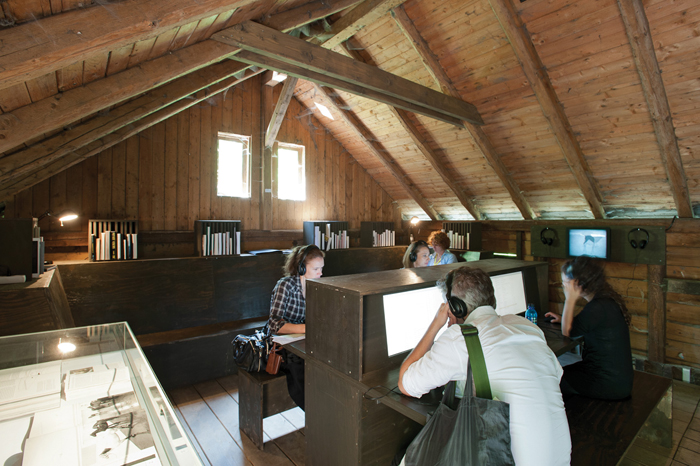
Tue Greenfort, The Worldly House. An Archive Inspired by Donna Haraway’s Writings on Multispecies’ Co-Evolution. Compiled and Presented by Tue Greenfort (details), 2012. Commissioned and produced by dOCUMENTA (13). Photo: Nils Klinger.
Throughout this year’s exposition, the present time of research and of aesthetic experience was punctuated by the presence in excess of history, technology, and information. Some of the less successful pieces, like Yan Lei’s Limited Art Project (2011–12), a feverish exhibition of 370 photo-realist paintings hung from the walls, ceiling, and storage racks, come across like a visual aid to Nicholas Carr’s 2011 book The Shallows. Each painting is based on an image that caught Yan Lei’s attention while browsing the Internet, with source photos ranging from attractive women to other works of art. Each day, three or four of the works in the exhibition are painted over in monochrome at a nearby car factory and reinstalled. What interest I had in the piece was generated not by this final act of deletion, but by scouring the images and marking their difference from and overlap with my own mental image library, as with the curator’s bookshelf.
On the other hand, the sound pieces created by Janet Cardiff and her partner George Bures Miller are particularly effective in communicating the tension between the desire to be fully present and the double pull of media and history.11 Their Alter Bahnhof Video Walk (2012) is a guided video tour of the Kassel train station that expands on the audio guides often found in museums, allowing the visitor to match his or her path exactly to that of Cardiff as she narrates her own walk through the space. The audio elements are so perfectly matched to the space that differentiating between real and recorded sounds is quite difficult. The fanciful choreographic elements of the video—a brass band, a ballerina, a pair of modern dancers—that Cardiff and Miller have created seem to lift out of their virtual space and suffuse the real space of the station. Rather than enlivening a now dead subject as most audio guides are intended to do, the video walks enhance an already living and present reality. Not that there isn’t an eye to history: throughout the piece Cardiff contemplates the history and architecture of the Bahnhof, noting for instance, the track where people were taken to the nearby concentration camp Breitenau. Expressing the pressure she feels at contemplating both the banality of the train station and the past it represents, Cardiff opines, “It’s hard for me to be in the present sometimes.” Before I heard this observation, the other viewers of Cardiff and Miller’s piece, drifting through the station engrossed in their devices, had actually been invisible to me, so ubiquitous are we in contemporary way stations such as the Bahnhof.
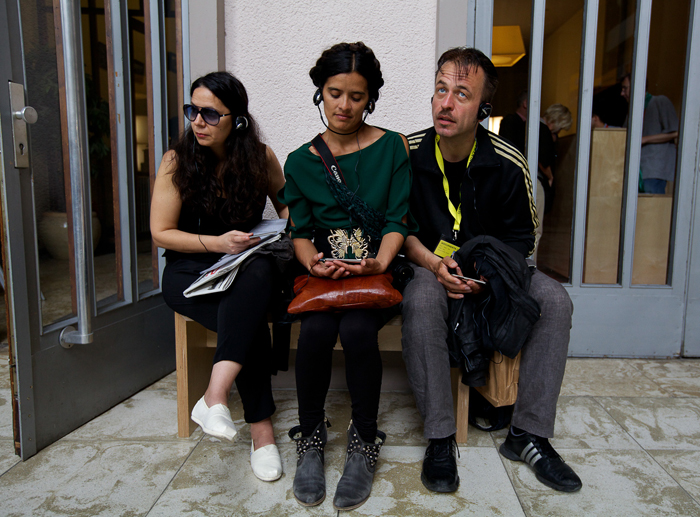
Janet Cardiff and George Bures Miller, Alter Bahnhof Video Walk, 2012. Commissioned and produced by dOCUMENTA (13) with the support of the Banff Centre, Alberta, through contributions by Laura Rapp and Jay Smith, Toronto; the Canada Council for the Arts; Galerie Koyanagi, Tokyo; with further support by Sennheiser (Canada) Inc. Courtesy the artists; Galerie Barbara Weiss, Berlin; Luhring Augustine, New York; Galerie Koyanagi, Tokyo. Photo: Henrik Stromberg.
If not expressive of every work in the show, Cardiff’s intrapersonal conflict summed up much of my experience of dOCUMENTA (13), as well as a certain reluctant utopianism on the part of the curator and her agents about the emancipatory possibilities of research-based art practice and a world beyond the digital divide.
Melissa Ragain is an assistant professor of art history at Montana State University.
